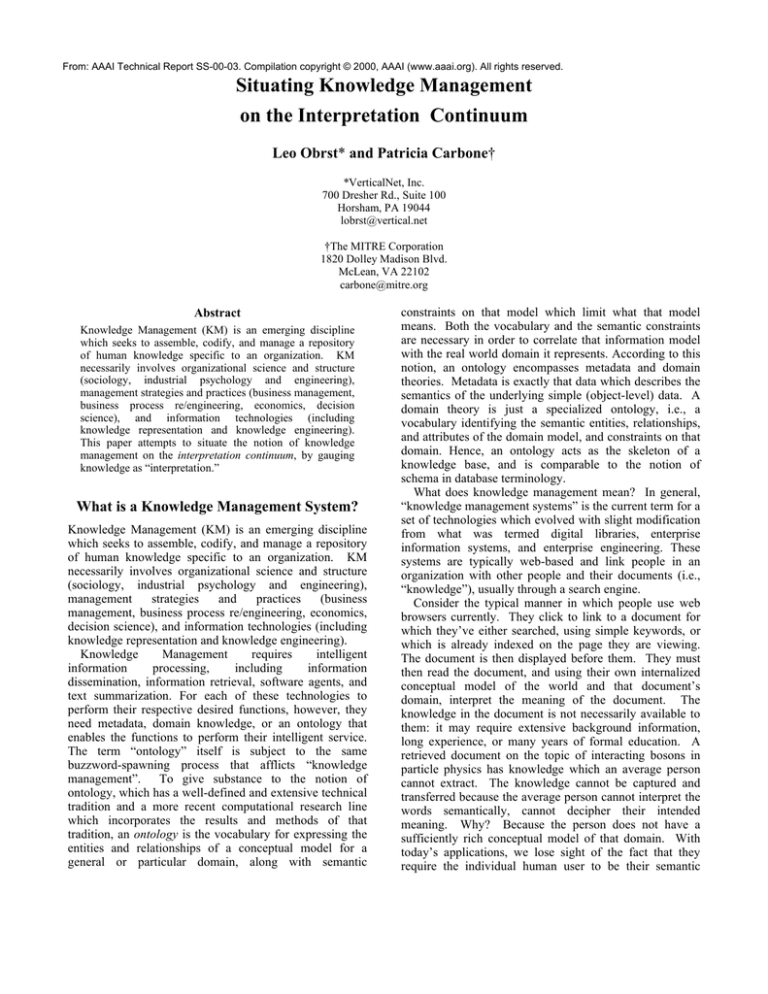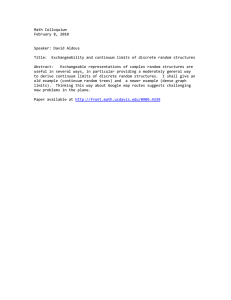
From: AAAI Technical Report SS-00-03. Compilation copyright © 2000, AAAI (www.aaai.org). All rights reserved.
Situating Knowledge Management
on the Interpretation Continuum
Leo Obrst* and Patricia Carbone†
*VerticalNet, Inc.
700 Dresher Rd., Suite 100
Horsham, PA 19044
lobrst@vertical.net
†The MITRE Corporation
1820 Dolley Madison Blvd.
McLean, VA 22102
carbone@mitre.org
Abstract
Knowledge Management (KM) is an emerging discipline
which seeks to assemble, codify, and manage a repository
of human knowledge specific to an organization. KM
necessarily involves organizational science and structure
(sociology, industrial psychology and engineering),
management strategies and practices (business management,
business process re/engineering, economics, decision
science), and information technologies (including
knowledge representation and knowledge engineering).
This paper attempts to situate the notion of knowledge
management on the interpretation continuum, by gauging
knowledge as “interpretation.”
What is a Knowledge Management System?
Knowledge Management (KM) is an emerging discipline
which seeks to assemble, codify, and manage a repository
of human knowledge specific to an organization. KM
necessarily involves organizational science and structure
(sociology, industrial psychology and engineering),
management
strategies
and
practices
(business
management, business process re/engineering, economics,
decision science), and information technologies (including
knowledge representation and knowledge engineering).
Knowledge
Management
requires
intelligent
information
processing,
including
information
dissemination, information retrieval, software agents, and
text summarization. For each of these technologies to
perform their respective desired functions, however, they
need metadata, domain knowledge, or an ontology that
enables the functions to perform their intelligent service.
The term “ontology” itself is subject to the same
buzzword-spawning process that afflicts “knowledge
management”. To give substance to the notion of
ontology, which has a well-defined and extensive technical
tradition and a more recent computational research line
which incorporates the results and methods of that
tradition, an ontology is the vocabulary for expressing the
entities and relationships of a conceptual model for a
general or particular domain, along with semantic
constraints on that model which limit what that model
means. Both the vocabulary and the semantic constraints
are necessary in order to correlate that information model
with the real world domain it represents. According to this
notion, an ontology encompasses metadata and domain
theories. Metadata is exactly that data which describes the
semantics of the underlying simple (object-level) data. A
domain theory is just a specialized ontology, i.e., a
vocabulary identifying the semantic entities, relationships,
and attributes of the domain model, and constraints on that
domain. Hence, an ontology acts as the skeleton of a
knowledge base, and is comparable to the notion of
schema in database terminology.
What does knowledge management mean? In general,
“knowledge management systems” is the current term for a
set of technologies which evolved with slight modification
from what was termed digital libraries, enterprise
information systems, and enterprise engineering. These
systems are typically web-based and link people in an
organization with other people and their documents (i.e.,
“knowledge”), usually through a search engine.
Consider the typical manner in which people use web
browsers currently. They click to link to a document for
which they’ve either searched, using simple keywords, or
which is already indexed on the page they are viewing.
The document is then displayed before them. They must
then read the document, and using their own internalized
conceptual model of the world and that document’s
domain, interpret the meaning of the document. The
knowledge in the document is not necessarily available to
them: it may require extensive background information,
long experience, or many years of formal education. A
retrieved document on the topic of interacting bosons in
particle physics has knowledge which an average person
cannot extract. The knowledge cannot be captured and
transferred because the average person cannot interpret the
words semantically, cannot decipher their intended
meaning. Why? Because the person does not have a
sufficiently rich conceptual model of that domain. With
today’s applications, we lose sight of the fact that they
require the individual human user to be their semantic
interpreter, i.e., the user must figure out the knowledge
contained in a document without any computer software
interpretation of the meaning of that document.
A true knowledge management system encapsulates
knowledge and at least partially symbolically interprets
that knowledge for a user, meaning that it categorizes the
knowledge in a way and to a fine degree so that the
knowledge is directly usable by the user. Having a
knowledge model that is conceptually close to what the
user desires ensures usability. The visionary promise of
robust knowledge management is a system which assists
the user in obtaining and interpreting knowledge at an
arbitrary level of understanding commensurate with a
user’s own knowledge and desired level and mode of
presentation. It is the degree of automatic interpretation
which is controversial, however.
Knowledge as Interpretation
With the rise of the availability of information and traffic
related to information on the Internet comes a concomitant
need to exploit and manage such information flow and and
its storage using more intelligent means. Because the
information is actually an information continuum (to be
termed "interpretation continuum" in this paper) which
ranges from completely unstructured data to very
structured knowledge, a variety of intelligent methods
must be employed to filter, to fuse, and to represent data
which ultimately becomes user- and institution-level
knowledge.
Data, Information, Knowledge
The terms data, information, and knowledge are usually
used in ill-defined ways, which is acceptable in colloquial
conversations where only a rough, intuitive notion of their
distinctive meanings are needed. There is a danger,
however, that such usage may result in an obliteration of
crucial technical distinctions, with the possible result that
these terms either become synonyms or equivalently that
one term begins to stand for all, but in a watered-down
fashion devoid of content.
This paper will not try to give precise formal definitions
to these three terms, but instead informally delineate their
meanings. By doing so, we hope to show that what we
have called the "information continuum" in the
introduction above is actually better termed the
"interpretation continuum".
In this view, data and knowledge are simply endpoints
on (for our purposes here) a linear continuum, as the
following figure suggests.
interpretation continuum
data:
relatively
unstructured
knowledge:
very
structured
Figure 1. The Interpretation Continuum
That which is nearer the left side of the continuum is
termed data; that which is nearer the right side is termed
knowledge, though in general the distinction between any
two points on the line is more appropriately expressed in
terms of their lesser or greater structure. But structure
itself, though important, is not the crucial determining or
characteristic factor for the continuum: interpretation is.
Structure is a side effect of the degree of interpretation
required. Knowledge is the relatively complex symbolic
modeling (representation) of some aspect of a universe of
discourse (i.e., that which we can talk about as human
beings); data is a relatively simple symbolic modeling.
Knowledge = Data + Interpretation
Information is here used in its more technical sense
derived from Shannon: information is a measure of the
extent to which a piece of knowledge tells you something
which you did not previously know.
Hence, the
information contained in some piece of data/knowledge
depends on what a person already knows and in general
will vary from individual to individual. Information
represents change in knowledge, i.e.,
New Knowledge = Old Knowledge + Information
But what now is interpretation and why is it important?
Interpretation is the mapping between some
structured set of data and a model of some set of
objects in a universe of discourse with respect to the
intended meaning of those objects and the
relationships between those objects.
Interpretation, therefore, is the mapping between notations
(which we will call "glyphs"), e.g., strings of characters
from some alphabet (for text) or some set of defined binary
encodings (for graphics, video, etc.), and what those
notations are intended to mean in a human-defined
universe of discourse.
Notations (or glyphs) are
meaningless symbols unless they are given an
interpretation, i.e., mapped to objects in a model.
Interpretation is semantics: it is interpreting the syntactic
glyphs with respect to their intended semantics.
Now, typically the model lies in the mind of the human.
We understand, which means: we symbolically represent in
some fashion the world, the objects of the world, and the
relationships among those objects. We have the semantics
of (some part of) the world in our minds: it is structured
and interpreted. When we view a textual document, we
see glyphs on a page and interpret those with respect to
what they mean in our mental model; that is, we supply the
semantics. If we wish to assist in the dissemination of the
knowledge embedded in a document, we make that
document available to other human beings, expecting that
they will provide the semantic interpreter (their mental
models) which will make knowledge out of the notations
(glyphs) on the document pages. There is no knowledge
there without interpretation; interpretation makes
knowledge out of squiggles on a page.
However, if we wish to have the computer assist in the
dissemination of the knowledge embedded in a document,
we need to partially automate the interpretation process,
which means we need to construct and represent in a
computer-usable way a portion of our mental model. What
does that mean? We turn to this question in the next
section.
Knowledge Issues: Acquisition,
Representation, Manipulation
Much of the data now being made accessible to individuals
via the Internet are structured in relational databases.
Other kinds of data exist as textual and graphical
documents, video, speech, and other specialized data
stores. All of these data sources, however, are relatively
unstructured to moderately structured. Relational
databases, which have both an intensional database (the
generic information or schema, i.e., part of the metadata)
and an extensional database (the instances or tuples of the
schema), still greatly rely either on application code for the
semantic interpretation of their data or, as is the case in
general for documents and relatively less structured data,
on human beings such as database administrators, users,
etc. Their primary purpose is for storage and ease of
access to data, not complex use; software applications
(with the data semantics embedded in nonreusable code via
programmers) and human beings must focus on data use,
manipulation, and transformation, all of which require a
high degree of interpretation of the data.
To partially automate the interpretation process (i.e., to
shift some interpretation ability to the computer from the
human), in recent years stochastic methods have been
employed. These range from the data mining of
statistically relevant patterns in relational databases, to the
use of statistical techniques in natural language processing,
image processing, etc. What most of these shallower (that
is, interpretation-nonintensive) methods have in common
is the attempt to discover statistically significant
correlations of data, words, relatively unstructured units,
and by those correlations infer semantic significance. It is
assumed that co-location or co-occurrence within some
defined context signifies a semantic relation. What that
semantic relation is, of course, must be conceived
(interpreted) by a human being who inspects the
statistically significant patterns. These methods however,
remove at least a portion of the noise from relatively
unstructured data, performing a filtering function, and
display before the interpreting human a subset of what can
become knowledge once the human interprets it. Such
methods attempt to bypass the knowledge bottleneck
encountered by a previous generation of technologies
epitomized by expert systems: capturing complex
knowledge requires much work in elicitation from domain
experts.
Deep knowledge management, it was thought, requires
time-consuming, responsible, and consistent knowledge
acquisition; consistent (or at least partition-bounding the
inconsistent), semantically correct, and expressive
knowledge representation; tractable, semantically-licensed,
sound but nonmonotonic reasoning; and ongoing
knowledge maintenance. Such an effort was in general
deemed too resource-intensive by industry. Coupled with
extravagant claims made by a small set of researchers, and
thus generative of unrealizably high expectations, this
perception quashed or at least curtailed efforts toward deep
representation. The need for such deep representation,
however, continues and in fact has increased: to maximize
the knowledge we can utilize, we must shift more of the
burden of interpretation onto our computers.
Figure 2. displays the interpretation continuum
mentioned earlier, but now annotated with additional
information on methods and technologies (along the
bottom) and types of knowledge (along the top) as one
progresses from data rightward to knowledge.
If all agree that both shallow and deep methods and
representations should be employed, that increased
knowledge utility, hence increased computer-assisted
interpretation is desirable, then the question becomes
"How might shallow and deep methods and representations
be combined?" A related question is: "Are there promising
technologies which might help combine shallow and
deep?"
Conclusions and Challenges
In the not too distant past, knowledge management
research concentrated on the representation and storage of
and reasoning against the metadata or structured
knowledge of a domain. As such, knowledge management
was synonymous with “knowledge base management”.
With the recent emphasis on building “knowledge
management” for a corporation, however, there has been a
displacing surge of interest in the more cultural and
political issues to encourage and enforce knowledge
management in an enterprise. This recent emphasis has its
origins in business process re/engineering and business
management methodologies which seek to build a
“knowledge corporation”. Without some kind of
knowledge representation and storage of the domain and
the inherent metadata associated with a vast array of
differently structured data, and sound methods to
automatically reason about the knowledge, however, the
technologies to facilitate a true knowledge management
system will not be available nor useful. We must go
rightward
on
the
interpretation
continuum.
knowledge
bases:
concepts,
relations,
i.e., metadata,
inference
databases,
patterns, rules
code to
interpret
these
shared, learned,
consistent
knowledge representation,
bounded im/precision,
uncertainty
constraint satisfaction, partial knowledge
human
interpreted
computer
interpreted
in terpreta tio n co n tinuu m
random
data:
relatively
u nstru ctured
stochastic
data
mining
information retrieval
display all
raw documents,
all interpretation
performed by
human
symbolic
find & correlate
patterns
in raw documents,
displaying only
matching documents
knowledge
discovery,
composition
kno w led ge:
very
structured
logical
summarization, ontology induction
content extraction,
nlp
store and
interrelate
patterns via
a conceptual
object model,
i.e., ontology,
& link to
documents;
collaboration
automatically
acquire concepts,
evolve ontologies
into domain
theories, &
link to institution
repositories
agent: computer assuming roles of human
Figure 2. The Interpretation Continuum Revisited
automatically
span domain theories
and institution
repositories;
reason and
communicate with
fully interpreting computer;
decisions made by human





